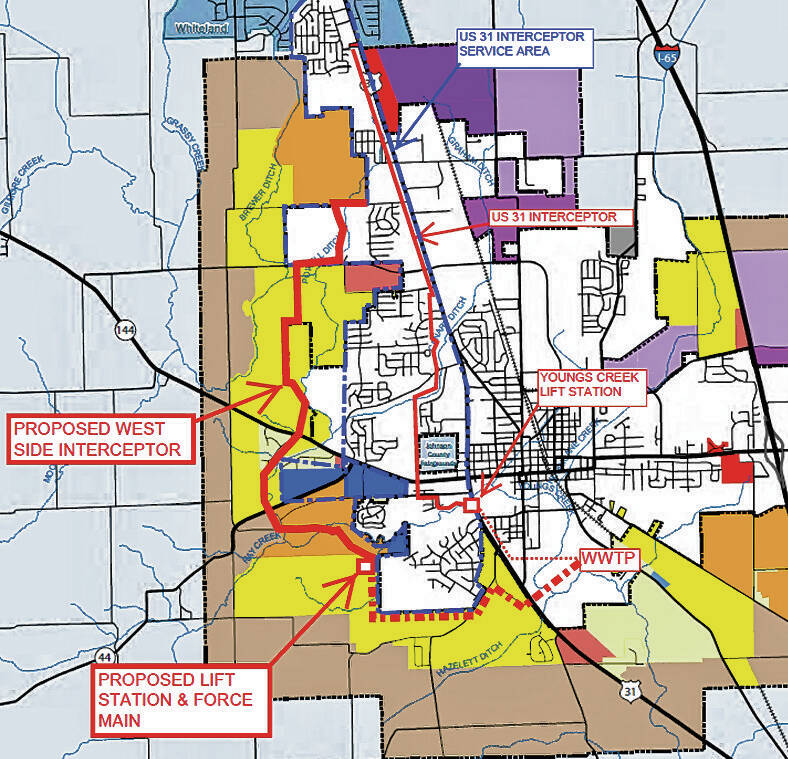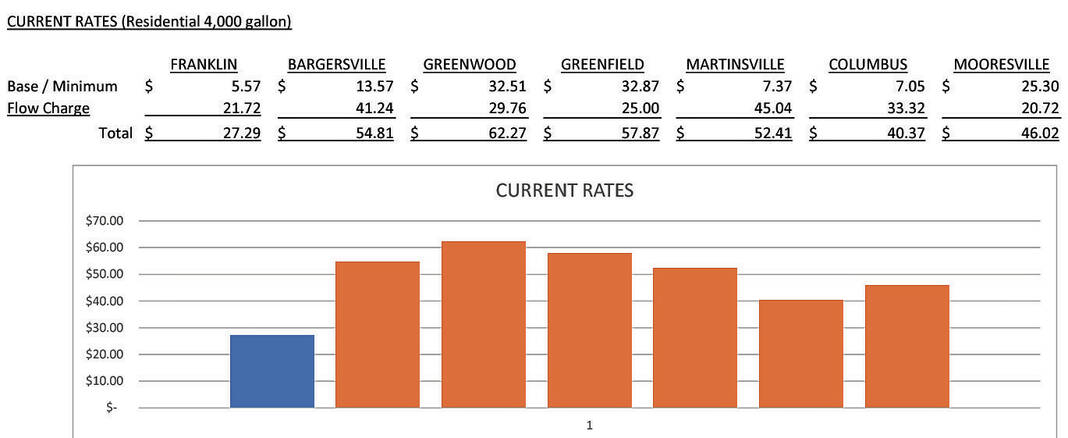Franklin residents may see their wastewater rates increase by at least $24.12 to pay for wastewater projects worth approximately $46 million.
The Franklin City Council heard the introduction of a new wastewater rate ordinance last week. The new rates would pay for a treatment plant expansion and phase two of the West Side Regional Interceptor project. Residents may see their rates go from $27.29 to at least $51.41 for 4,000-gallon residential usage.
If the city goes with a 25-year amortization for the bond, the proposed rate is $51.41 at 4,000 gallons residential usage, said Jeff Peters, the city’s financial consultant.
However, the council is considering changing the ordinance to reflect a 20-year amortization rate instead, which would increase the rate to $54.03. By doing that, the city’s savings and interest would be approximately $7.95 million across the 20-year period.
Because the city is considering altering the amortization rate of the bond, the proposed rates haven’t been pinned down yet.
The city council will hold a public hearing Aug. 19 for the new wastewater rate ordinance.
Proposed projects
The new wastewater use rates will pay for an expansion of the wastewater treatment plant and the second phase of the West Side Regional Interceptor project.
The wastewater treatment plant expansion will replace and update aging equipment, provide more energy-efficient processes and increase design flow/treatment capacity to allow for future development and growth, according to the city council presentation.
The existing facility was built in 1996 and is approaching 30 years old. The design average flow is 5.13 million gallons per day.
By adding one more tank to each wastewater treatment plant process and replacing equipment with larger units, the project would increase capacity to 7.5 million gallons per day.
“So if you can imagine the city of Franklin growing by 50%, that’s quite a bit, so it puts the city in a good position as far as treatment capacity for many years to come,” said Gary Ruston, technical services director at Wessler Engineering.
In 2021, the city reached 92% capacity at the plant, which raised a red flag and started conversations about increasing the plant’s capacity.
“The flows have trended down the last two years. The city has done some … projects that have likely helped reduce those flows,” Ruston said. “But the flows to the treatment plant are highly dependent on wet weather, rainfall. You get into a wet year in 2024, then you could be back up at 90% capacity.”
The estimated cost for the project, including construction and non-construction costs, is $33.2 million. The project would take 40 months and could be complete by fall 2027.
As for the West Side Regional Interceptor project, the plan is to construct an 18-to-24 inch gravity sewer and a new regional lift station and force main on the west side of the city to prepare for additional housing a business growth.
In 2019 or 2020, Wessler Engineering did a sewer master plan for the city based on the 2013 comprehensive plan, Ruston said. The company mapped out long-term needs to show anticipated growth areas and different types of development or zoning that are anticipated in the future.
Two major areas needed sewer service: east of I-65 and the west side of the city.
In 2022, the city pursued the East Side Regional Interceptor project that covered the area east of I-65. Ruston said a new interceptor and lift station are needed for future growth northwest, west and southwest of the city.
The existing U.S. 31 Interceptor flows to the Young’s Creek Lift Station, serving the entire area west of U.S. 31 which is approximately a third of the city, according to the presentation. The interceptor and lift station are at capacity during heavier rain events.
Phase one of the project was completed in December 2023. It tied into the Branigin Road lift station and took it out of service, ran through the high school property along Powell Ditch and connected to the existing Commerce Drive lift station which previously served just the high school, Ruston said.
As a temporary solution, it pumps to U.S. 31 and opens the area northwest of the high school for development, he said.
For phase two of the project, the Commerce Drive lift station would pump through a new force main to a new gravity sewer, which would parallel Young’s Creek to a new pump station on the southwest side and then to the new wastewater treatment plant.
The proposed remaining cost of phase two is roughly $13 million and construction is anticipated to take 12 months, concluding in spring 2027.
Rate study
To determine how much rates should go up for the projects, Peters conducted a wastewater rate study and shared his findings with the council.
For residential rates at 4,000 gallons a month per usage, Peters said the current rate is $27.29, adding together the base/minimum and flow charge. Compared to Bargersville, Greenwood, Greenfield, Martinsville, Columbus and Mooresville, Franklin has the lowest rate, according to the presentation.
With the proposed rate change, Franklin will remain below most of those cities except for Columbus and Mooresville. Columbus is at $40.37 and Mooresville is at $46.02.
In 2023, the total operation and maintenance expenses for the sewer works were approximately $4.5 million, including adjustments for the 2025 budget and 3% inflation for two years. The city will need to produce at least 125% of revenue beyond what the city needs for debt service. That amount needs to be approximately $1 million, Peters said.
That $1 million can be spent toward maintaining the sewer works infrastructure. After the city has finished the projects, it will fund debt service payments.








